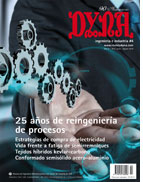INFLUENCE OF ULTRASONIC VIBRATION HONING PARAMETERS ON CAVITATION BUBBLE COLLAPSE TEMPERATURE
Keywords:
pulido por vibración ultrasónica, burbuja de cavitación, temperatura de colapso, erosión por cavitación, ultrasonic vibration honing, cavitation bubble, collapse temperature, cavitation erosionAbstract
ABSTRACT: ltrasonic cavitation, particularly its mechanism and bubble dynamic behavior, has attracted considerable interest in ultrasound applications. However, the thermal damage of cavitation bubble collapse is difficult to study because of its complicated mechanism. In this work, the formation mechanism of cavitation bubbles in ultrasonic vibration honing (UVH) was analyzed. A dynamic model was established on the basis of the UVH mechanism, and bubble collapse temperature was presented under the law of thermodynamic equilibrium. Six honing parameters (i.e. rotation speed of the honing head, ultrasonic wave vibration amplitude, reciprocation speed of oilstone, initial bubble radius, ultrasonic wave stress amplitude, and honing pressure) were studied to explore the influence of bubble movement radius and collapse temperature. For the given parameters, the bubble movement radius and crack temperature were simulated by changing the honing parameter conditions. The bubble collapse radius ranged from 100 µm to 200 µm, and the highest and the lowest crack temperatures were 1,400 K and 300 K, respectively. The cavitation erosion on an aluminum foil surface corresponded to the thermal damage caused by the bubble collapse. The conclusions obtained in this study provide significant reference values for the mechanism of cavitation collapse and can be applied in ultrasonic cleaning, particularly in descaling oxide layers. Keywords: ultrasonic vibration honing, cavitation bubble, collapse temperature, cavitation erosionDownloads
Published
2016-07-01
Issue
Section
ARTICULOS

